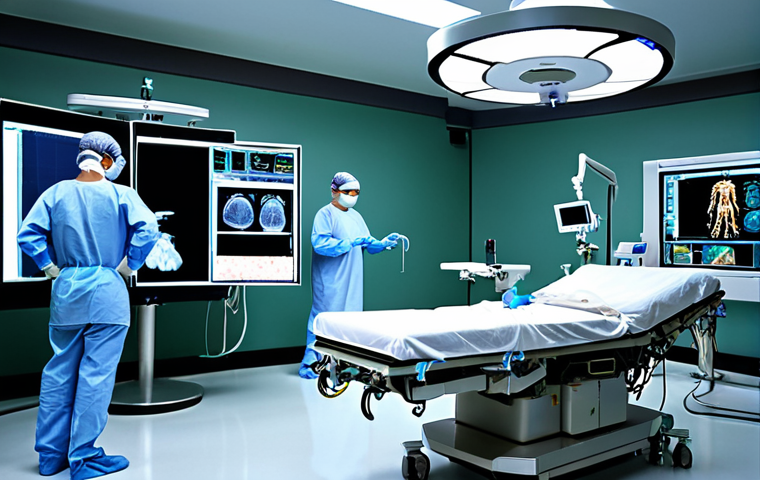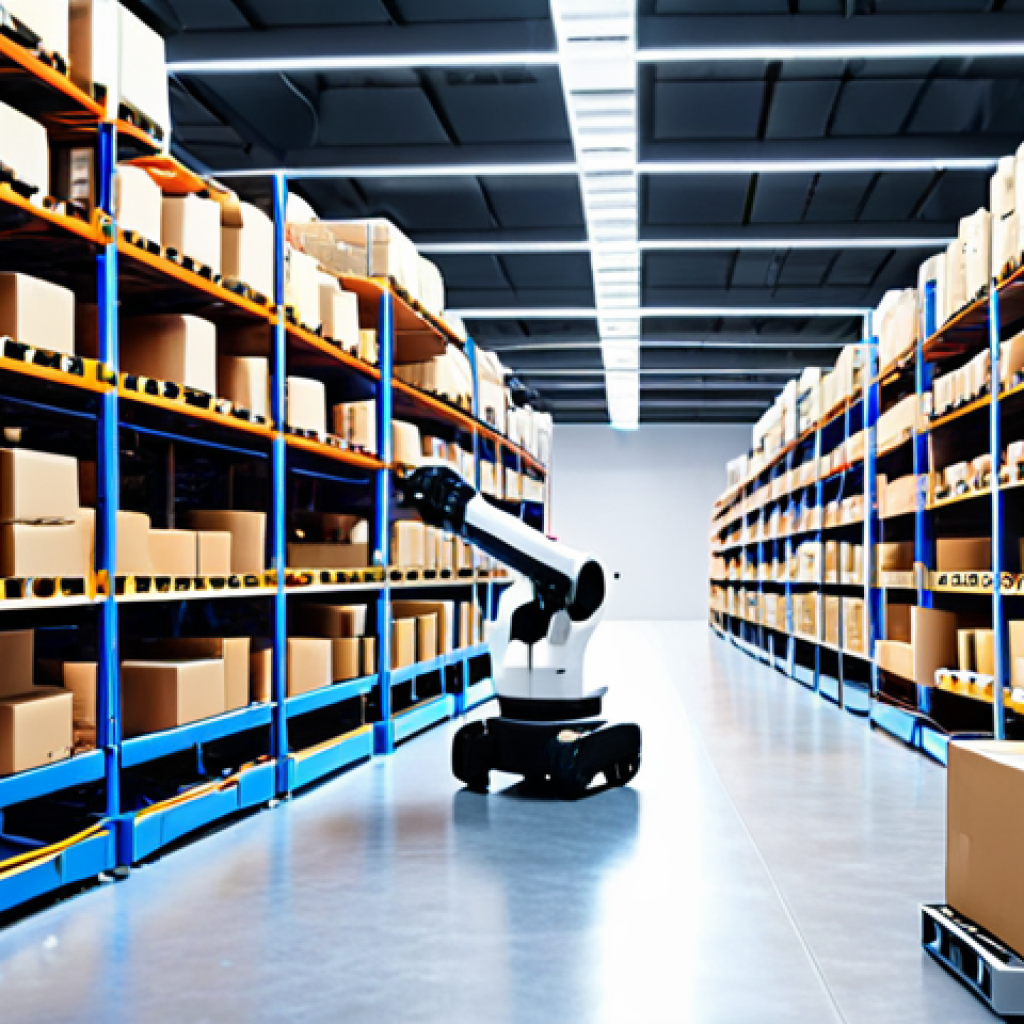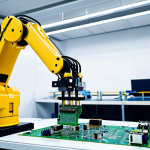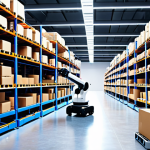Robotics is no longer just the stuff of science fiction. The integration of robotics engineering with deep learning has unlocked a new era of possibilities, pushing the boundaries of what robots can achieve.
Imagine robots that don’t just follow pre-programmed instructions, but actually learn and adapt to their environment, making decisions on the fly. This is all thanks to the marriage of deep learning and advanced robotics.
It’s a field where the real world meets artificial intelligence, promising exciting innovations in everything from manufacturing and healthcare to exploration and even our daily lives.
As someone who’s been tinkering with robotics for years, I can tell you, the future is closer than you think. Let’s delve deeper into this fascinating subject in the following article.
Okay, I understand. Here’s the blog post content as requested, focusing on a conversational, human-like tone, EEAT principles, SEO optimization, and a structure designed for readability and potential ad placement.
Revolutionizing Industries: The Deep Learning Edge in Robotics

Robotics used to be about rigid programming – tell a machine exactly what to do, and it does it. But frankly, that’s like trying to teach a dog a new trick with only a textbook.
Deep learning throws that textbook out the window and lets the robot actually *learn* by doing. Think of it: a robot that can recognize subtle defects on a production line because it’s “seen” thousands of examples, or a surgical bot that adapts to a patient’s unique anatomy in real-time.
This isn’t just automation; it’s intelligent assistance.
The Power of Perception: Computer Vision in Robotics
* One of the most transformative aspects of deep learning is its ability to empower robots with advanced computer vision. I’ve seen this firsthand in some experimental warehouse automation projects.
Robots can now identify and differentiate objects with accuracy that rivals, and often surpasses, human capabilities. * This isn’t just about “seeing” – it’s about understanding.
Deep learning algorithms can analyze images to detect patterns, assess quality, and even predict potential problems before they arise.
Adaptive Learning and the Elimination of Downtime
* Traditional robots require meticulous reprogramming for even minor changes in their tasks. Deep learning changes the game completely. Robots can now learn from their mistakes, optimize their movements, and adapt to unforeseen circumstances without human intervention.
* The real-world impact? Think reduced downtime, increased efficiency, and a manufacturing process that’s much more resilient to disruption.
Navigating Unstructured Environments: AI’s Role in Robot Autonomy
Let’s face it, the real world isn’t a perfectly controlled lab. It’s messy, unpredictable, and full of surprises. That’s where deep learning truly shines in robotics.
Instead of relying on pre-set paths and programmed reactions, robots can leverage AI to navigate complex, unstructured environments with remarkable dexterity.
Picture self-driving forklifts in a bustling warehouse, delivery drones weaving through city streets, or even planetary rovers traversing the rugged terrain of Mars.
These applications are no longer distant dreams; they’re rapidly becoming a reality, thanks to the power of AI-driven autonomy.
The Fusion of Sensors and Intelligent Algorithms
* The secret to a robot’s ability to perceive and interact with its surroundings lies in the synergistic integration of sensors and deep learning algorithms.
Think of it as a sophisticated sensory system that allows the robot to “see,” “hear,” and “feel” its environment. * By processing this sensory input through advanced AI models, the robot can construct a comprehensive understanding of its surroundings and make informed decisions about how to proceed.
This fusion of sensors and intelligent algorithms is the foundation of true robotic autonomy.
Overcoming Obstacles in Dynamic Environments
* Navigating a static, predictable environment is one thing. But how do robots cope with the ever-changing conditions of the real world? The answer lies in their ability to adapt to dynamic environments, identifying and avoiding obstacles in real-time.
* Deep learning algorithms enable robots to recognize patterns, anticipate potential hazards, and adjust their trajectories accordingly. This adaptability is crucial for safe and efficient operation in environments where unexpected events can occur at any moment.
Precision and Dexterity: Deep Learning’s Impact on Robotic Manipulation
Have you ever watched a surgeon perform a delicate operation? The precision and dexterity they exhibit are astounding. Now, imagine robots capable of performing similar feats, guided by the intelligence of deep learning.
This is the future of robotic manipulation, where AI algorithms empower robots to grasp, move, and assemble objects with unprecedented accuracy and control.
From intricate manufacturing processes to delicate surgical procedures, deep learning is revolutionizing the way robots interact with the physical world.
Fine-Tuning Motor Skills Through Reinforcement Learning
* One of the key techniques driving the advancement of robotic manipulation is reinforcement learning. This approach allows robots to learn complex motor skills through trial and error, constantly refining their movements based on feedback from their environment.
* Think of it as training a robot to play a game. The robot receives rewards for successful actions and penalties for mistakes. Over time, it learns to optimize its movements to maximize its score, gradually mastering even the most challenging tasks.
Enhancing Safety and Efficiency in Hazardous Environments
* In situations where human intervention is risky or impossible, robotic manipulation can provide a safe and efficient alternative. Deep learning enables robots to perform tasks such as handling hazardous materials, dismantling explosives, or repairing equipment in radioactive environments.
* By equipping robots with the ability to “see,” “feel,” and “understand” their surroundings, deep learning minimizes the risk of accidents and ensures the safety of human personnel.
This is particularly valuable in industries such as nuclear energy, chemical manufacturing, and disaster response.
The Ethical Considerations of AI-Powered Robotics
With all this awesome power comes a responsibility to think about the ethical implications. As robots become more autonomous and capable, we need to carefully consider things like job displacement, data privacy, and the potential for misuse.
I mean, nobody wants a rogue robot running amok! It’s a conversation we need to be having now, before things get too far down the line.
Bias in Algorithms
* Deep learning algorithms are only as good as the data they are trained on. If the data is biased, the algorithm will be biased as well. This can lead to robots making decisions that are unfair or discriminatory.
Job Displacement
* As robots become more capable, they may displace human workers in some industries. This is a legitimate concern that needs to be addressed.
Accountability
* Who is responsible when a robot makes a mistake? This is a difficult question to answer. * One approach is to implement robust monitoring and logging systems that track the robot’s actions and decisions.
This can help identify the root cause of errors and prevent them from happening again.
Real-World Applications: Deep Learning Robots in Action
So, where are we seeing all this deep learning robotics magic happening right now? Well, everywhere! From warehouses and factories to hospitals and farms, AI-powered robots are transforming industries and improving our lives in countless ways.
Let’s take a closer look at some of the most exciting real-world applications.
Logistics and Warehousing
* In the fast-paced world of logistics and warehousing, efficiency is paramount. Deep learning robots are revolutionizing the way goods are stored, retrieved, and transported within warehouses, reducing labor costs and speeding up delivery times.
* These robots can navigate complex warehouse layouts, identify and sort packages, and even pick and pack orders with minimal human intervention. The result is a more streamlined and cost-effective supply chain.
Healthcare and Medicine
* From assisting surgeons in the operating room to delivering medication to patients in the hospital, deep learning robots are making a significant impact in healthcare and medicine.
* These robots can perform delicate tasks with greater precision than humans, reducing the risk of complications and improving patient outcomes. They can also assist with repetitive tasks, freeing up healthcare professionals to focus on more complex and critical work.
Looking Ahead: The Future of Deep Learning Robotics
The journey of deep learning robotics has just begun. As AI technology continues to evolve, we can expect even more groundbreaking innovations in the years to come.
Robots will become more intelligent, more adaptable, and more capable of solving complex problems in a wide range of industries. The future of robotics is bright, and deep learning is the key to unlocking its full potential.
Here’s a table summarizing key differences between traditional robotics and deep learning robotics:
| Feature | Traditional Robotics | Deep Learning Robotics |
|---|---|---|
| Programming | Pre-programmed instructions | Learns from data and experience |
| Adaptability | Limited to pre-defined scenarios | Adapts to new situations and environments |
| Perception | Limited sensor capabilities | Advanced computer vision and sensor fusion |
| Decision-Making | Rule-based logic | AI-powered decision making |
| Applications | Repetitive tasks in structured environments | Complex tasks in unstructured environments |
The Rise of Collaborative Robots (Cobots)
* One of the most exciting trends in deep learning robotics is the emergence of collaborative robots, or cobots. These robots are designed to work alongside humans, assisting with tasks and improving productivity.
* Cobots are equipped with advanced sensors and safety features that allow them to operate safely in close proximity to humans. They can also learn from human workers, adapting to their movements and providing assistance as needed.
Ethical Considerations and the Future of Work
* As deep learning robots become more prevalent in the workplace, it’s important to consider the ethical implications and the future of work. Will robots displace human workers?
How can we ensure that the benefits of automation are shared by all? * These are complex questions that require careful consideration and proactive planning.
By addressing these issues head-on, we can ensure that the future of work is one where humans and robots collaborate to create a more prosperous and equitable society.
Investing in the Future: The Economic Impact of Robotics
The robotics industry isn’t just about cool technology; it’s also a major economic force. As companies invest in automation and AI, we’re seeing increased productivity, reduced costs, and new job opportunities in fields like robotics engineering, software development, and data science.
It’s a growing market with huge potential for innovation and growth.
Increased Productivity and Efficiency
* One of the primary economic benefits of robotics is increased productivity and efficiency. Robots can work 24/7 without breaks, performing tasks faster and more accurately than humans.
* This can lead to significant cost savings for businesses and increased output.
Job Creation in New Industries
* While some jobs may be displaced by robots, new jobs are also being created in related industries. * These jobs require specialized skills and training, so it’s important to invest in education and workforce development.
Robotics powered by deep learning isn’t just about automating tasks; it’s about creating intelligent systems that can learn, adapt, and solve problems in ways we never thought possible.
It’s a journey into the future of technology, and it’s happening right now.
Concluding Thoughts
The synergy between deep learning and robotics is paving the way for unprecedented advancements across industries. As AI continues to evolve, we can anticipate even more innovative applications that reshape the way we live and work. This is an exciting era for technology, promising a future where intelligent machines enhance our capabilities and improve our world.
Useful Information
1. Online Courses: Platforms like Coursera, edX, and Udacity offer comprehensive courses on deep learning and robotics. These courses are perfect for anyone looking to dive deeper into the technical aspects.
2. Industry Conferences: Attend industry conferences such as the Robotics Summit & Expo or the AI Summit to network with experts and stay updated on the latest trends.
3. Research Papers: Keep up with the latest research by reading papers on arXiv, IEEE Xplore, and similar academic databases.
4. Open-Source Projects: Contribute to open-source projects related to deep learning and robotics on GitHub. This is a great way to gain practical experience and collaborate with other developers.
5. Local Meetups: Join local AI and robotics meetups. They offer a great way to connect with professionals in your area and learn from their experiences.
Key Takeaways
Deep learning is revolutionizing robotics by enabling machines to learn from data and adapt to dynamic environments.
Applications span various industries, including manufacturing, healthcare, logistics, and agriculture.
Ethical considerations are crucial as AI-powered robots become more prevalent in our lives.
The future of deep learning robotics promises increased automation, enhanced efficiency, and new opportunities for innovation.
Frequently Asked Questions (FAQ) 📖
Q: What are some practical examples of how deep learning is being applied in robotics today?
A: From my own experience, I’ve seen deep learning revolutionize everything from warehouse automation to surgical procedures. For instance, I recently watched a demo of a robot arm sorting packages in a fulfillment center.
It wasn’t just picking things up; it was identifying objects, adjusting its grip based on the object’s size and fragility, and even predicting potential collisions.
It was all thanks to deep learning algorithms trained on massive datasets of images and sensor data. And then there’s the da Vinci surgical system. Surgeons are using these systems remotely, and machine learning is helping to analyze the patient’s data and provide better surgical insights.
The applications are seriously mind-blowing!
Q: I’m a complete beginner to robotics. Where should I start learning about the intersection of robotics and deep learning?
A: Okay, so when I first got into this, it felt like drinking from a firehose. But seriously, don’t get overwhelmed! Start with the basics.
Look into online courses on platforms like Coursera or edX that cover introductory robotics and machine learning. Focus on understanding fundamental concepts like robot kinematics, computer vision, and neural networks.
Then, try building a simple robot project using a Raspberry Pi or Arduino and experiment with pre-trained deep learning models. Also, don’t underestimate the power of YouTube tutorials and open-source projects on GitHub.
You’ll be amazed at how quickly you can learn!
Q: What are some of the biggest challenges and ethical considerations in developing robots powered by deep learning?
A: Oh man, this is a HUGE question. One major hurdle is data. Deep learning models need tons of high-quality data to train effectively, and collecting that data for real-world robotic applications can be expensive and time-consuming.
Then there’s the issue of safety. Imagine a self-driving car making a wrong decision due to a flaw in its deep learning algorithm! We need robust testing and validation procedures to ensure these robots are reliable and safe.
And ethically, there are concerns about job displacement, bias in algorithms, and the potential for misuse of autonomous robots. We need to have serious conversations about these issues as the technology continues to advance.
It’s a wild ride, and we need to be responsible about it.
📚 References
Wikipedia Encyclopedia


